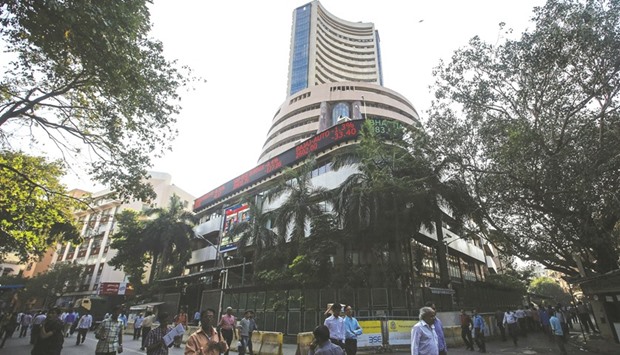Stocks signed off 2016 on a cheerful note, with the Sensex surging over 260 points yesterday to close at over a fresh two-week high of 26,626 on the final trading session of the year, amid positive Asian cues. The beginning of January 2017 series of futures and options made investors upbeat.
With the deadline for depositing banned notes ending yesterday and ahead of the approaching Union budget, investors accelerated buying activity with hopes that the government might come up with a series of steps to boost the economy. Sentiment turned for the better after finance minister Arun Jaitley on Thursday said there has been a sharp jump in tax collections, belying fears of a sharp slowdown in the economy in view of demonetisation.
After a higher start, the 30-share index hit the day’s high of 26,678.60 and closed up 260.31 points, or 0.99%, at 26,626.46 — a level last seen on December 13 when it settled at 26,697.82.
It had gained 155.47 points on Thursday as December derivatives contracts expired amid recovery in the rupee. The Nifty rose 82.20 points, or 1.01%, to end at 8,185.80, after touching the day’s high of 8,197. For the week, the Sensex and the NSE Nifty recorded a rise of 585.76 points, or 2.24%, and 200.05, or 2.50%, respectively.
“The euphoria continued on the last trading day of the year, hoping for radical remarks in the Prime Minister’s speech on Saturday. Additionally, an expectation of tax sops in the budget, weakness of the dollar and robust tax collection are adding to the positive sentiment,” said Vinod Nair, head of research, Geojit BNP Paribas Financial Services.
The year saw the Sensex zooming to a high of 29,077.28 on September 8 and a low of 22,494.61 on February 29. Today’s closing meant a net gain of 508.92 points, or 1.94% from its last year-end close of 26,117.54.
During the year, the Nifty gained 239.45 points, or 3.01%. The gauge had climbed to a high of 8,968.70 on September 7 and touched a low of 6,825.80 on February 29.
Domestic institutional investors (DIIs) bought shares worth a net Rs957.83 crore as per provisional data. But foreign portfolio investors (FPIs) net sold shares worth Rs662.29 crore on Thursday.
GAIL saw the maximum jump, up 3.07%, followed by Sun Pharma (2.59%), ITC (2.31%) and PowerGrid (2.14%). In terms of sectors, the rally was driven by FMCG (up 1.67%), power (1.30%), healthcare (1.11%) and realty (1.10%).
Broader markets such as BSE mid-cap and small-cap ended higher with gains of 1.07% and 0.77%, respectively.
Meanwhile the rupee yesterday closed stronger against the US dollar on last day of the year 2016, tracking the gains in the local equity and Asian currencies markets. Traders are cautious ahead of the prime minister Narendra Modi’s speech today.
The rupee closed at 67.93 per US dollar, up 0.25% from its previous close of 68.10. The home currency opened at 67.96 against the US dollar and touched a high and a low of 67.85 and 68 respectively.
“Rupee is gaining on selling of the greenback by exporters in view of a weak dollar amid strong revival in the domestic equities,” said a local broker requesting anonymity. This was the sixth consecutive year when the rupee ended weaker. So far this year, it has fallen 2.60%.
Rupee is depreciating since 2011 and wakened 34.19% against the dollar from Rs44.71 a dollar on December 31, 2010 to Rs67.93 a dollar now.
“This year characterised by a number of political events such as US elections, Demonetization in India, Brexit in the UK to name a few.
This made it extremely difficult to predict the currency moves which is likely to continue in the new year as the markets awaits policies from the Trump administration, Brexit proceedings and elections in France and Germany,” said Amit Gupta, Co –Founder and CEO TradingBells.
“With the US Federal Reserve raising its interest rates in 2016 and predicting three more such hikes in 2017, it is likely that the USD will continue to see increased demand next year keeping the rupee under pressure”, Gupta added.
Rupee has depreciated most in the Asian currencies market over the six year period between 2011 and now. After rupee, the Indonesian rupiah weakened 33.1%, Malaysian ringgit 31.3%, Japanese yen 30.6%, Thai baht 16.03%, Philippines peso 12% Singapore dollar 11.2%, Taiwan dollar 9%, South Korean won 6.8%. However, Hong Kong dollar strengthened marginally by 0.24% in this period.
Among the Brics nations, Brazilian real weakened 48.88%, Russian rouble 50.18%, China renminbi 5.05%, and South African rand weakened 51.6%.
This year rupee weakened mostly as the foreign institutional investors pulled out over $10bn from local equity and debt markets since November 8, the day when Donald Trump elected as a US president, resulted gains in dollar index and US bond yields on the fear of more rate hikes by the US federal reserve on the prospect of increased spending under President-elect Donald Trump.
On December 14, the US Federal Reserve raised interest rates by a quarter percentage point and signalled a faster pace of increases next year as the Donald Trump administration takes over with promises to boost the US economy through tax cuts, spending and deregulation.
Over these six years, the dollar index which measures the US currency’s strength against major currencies gained 29.45%. The index gaining since four consecutive years and So far this year it gained 3.72%.
The 10-year-bond yield slumped massive 125 basis points in 2016, its steepest decline since eight year. This will be the third consecutive year of falling. Since 2014 year, it dropped around 231 basis point.

People walk by the Bombay Stock Exchange building in Mumbai. The BSE Sensex ended higher by 260.31 points to 26,626.46 yesterday.


